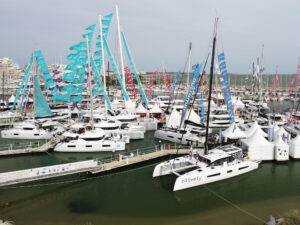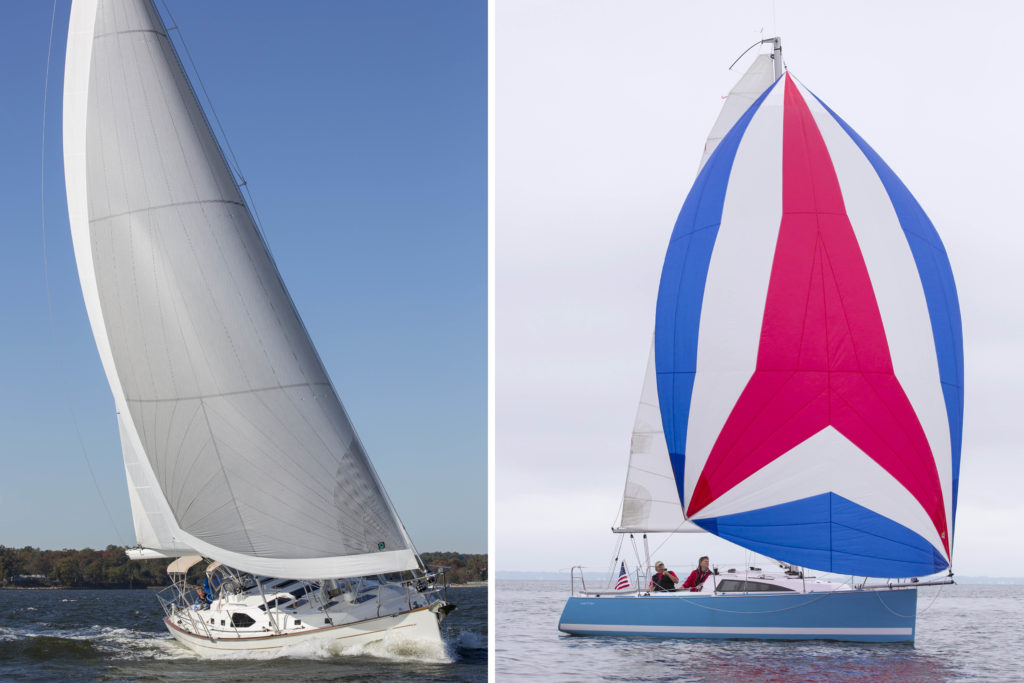
Top-down furlers, designed to tame large, billowing downwind sails, have greatly reduced the sailhandling headaches faced by shorthanded crews, but they open the door to a prodigious array of sails that can be designed to fit your boat and sailing plans. (For more on top-down furlers, see.
Modern downwind sails designed to be set and snuffed using socks or some type of flexible furler basically fall into two camps: full-bodied asymmetric cruising spinnakers, for very broad reaching and running, and slightly flatter jib-spinnaker hybrids that excel in light wind and at tighter angles, meaning they can be flown anywhere from a close reach to well off the breeze. Any of these sails will be able to sail closer reaches in lighter wind and farther downwind as the breeze builds, but generally speaking, the flatter the sail, the higher the angles that will be attainable. In an ideal world, both the light-air upwind/close-reaching sail and the running spinnaker would find their way into your inventory, but based on your boat and budget, you may decide one of these categories fits your needs better than the other.
Asymmetric Cruising Spinnakers
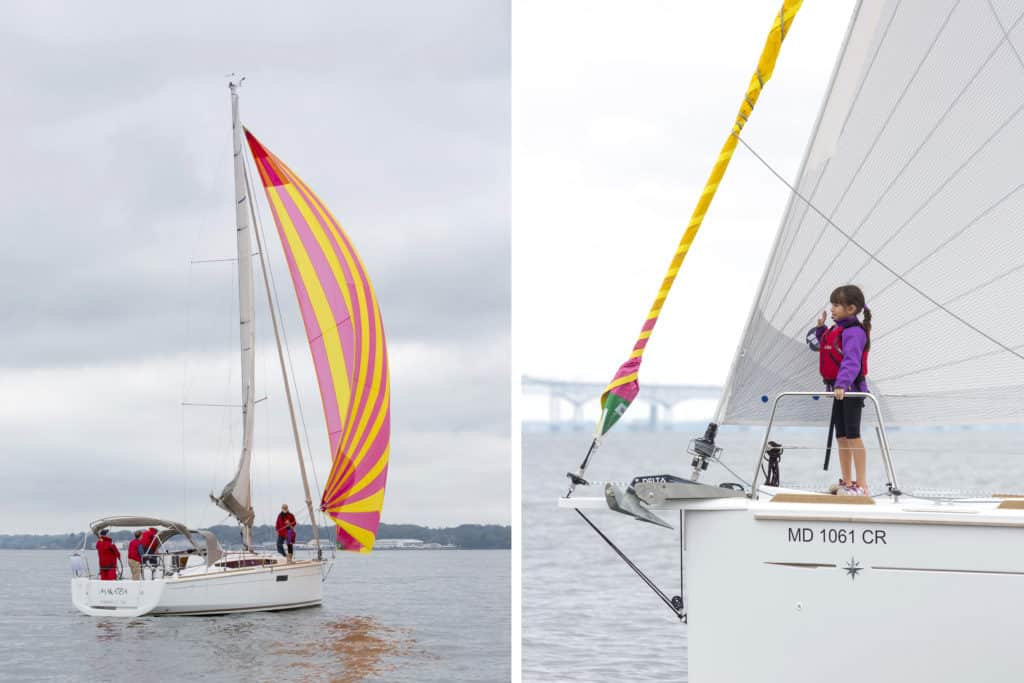
In racing circles, sailors used to set symmetric spinnakers, which required a heavy pole and many bodies on the bow. These sails were quite powerful and had sides of equal length, requiring the pole to be jibed along with the sail. Sailmakers solved the sailhandling problem with asymmetric sails, whose luff is somewhat longer than the leech, eliminating the need for a pole and allowing the sail to be jibed inside or in front of the foretriangle. (The furler further simplifies things because the sail can simply be rolled in and set on the other tack after jibing.) With a top-down furler, the tack of a spinnaker attaches to a free-spinning ring on the top of the furling drum, which is fastened to the deck or bowsprit. The head is attached to a fitting at the top of the anti-torsion cable; the cable spins when you pull the furling line, rolling the sail around the cable from the top down. When set, the sail flies freely away from the cable, allowing for a moderately deep downwind sail with a luff that projects to windward. Most sailmakers offer a sail that can be rigged on such a system.
“What makes a top-down furler better than a bottom-up furler for cruising spinnakers is that it can handle furling a sail with wider ‘shoulders,’ as long as they’re not too high,” says Judy Blumhorst, of Hyde Sails. “The shoulders help the sail float out to windward and make it possible to sail deeper angles downwind.” For a boat with a traditional overlapping genoa, like a Bristol 41.1, Blumhorst recommends a cruising asymmetric sail optimized for broad reaching and running in light to moderate breeze. This is because the big genoa is adequate for close reaching in these conditions, but it would be blanketed by the mainsail at deeper angles. Additionally, says Blumhorst, if you have a short bowsprit that gets the spinnaker out in front of the boat, the sail will be capable of sailing as deep as 155 degrees apparent (a very broad reach) in moderate wind up to 15 knots, and up to about 90 degrees apparent for a beam reach.
Hood Sails’ Multi-Purpose spinnaker can reach from about 70 degrees apparent (a close reach) in light air to 130 degrees apparent (a broad reach) in up to about 20 knots true if you’re attentive to steering and trim, says Hood’s Joe Cooper. “The shape is very forgiving, so it can roll in at the luff quite a bit before collapsing,” he adds.
Jerry Latell, of Ullman Sails Virginia, suggests a similar angle range — 75 degrees apparent in light air and up to 130 degrees in breeze — for Ullman’s All-Purpose spinnaker. “Sailmakers can easily build a more specialized sail that has a profile geared toward running or close reaching, but the All-Purpose spinnaker, with its broad range, fits the bill for most cruisers,” he says.
Butch Ulmer, of UK Sailmakers, recommends cruising spinnakers to his customers because they make it possible to sail at speeds typically achieved only by turning on the motor. “Thus a cruising chute is invaluable when making long passages, because sailboats have such limited fuel capacity,” he says. Ulmer likes lightweight sailcloth because the typical cruiser won’t use the chute in a lot of wind, but he adds that material weight and specific sizes can be fine-tuned for your home port’s weather or the conditions expected during a long passage.
Another consideration when purchasing gear is whether the furler unit is big enough for the sail you plan to use, says Keith Magnussen, of Ullman Sails Newport Beach. An underpowered unit will make it hard (or impossible) to roll in the sail.
One caveat: “If you’re going to get a big, fat running sail for dead-downwind sailing, we still recommend a dousing sock,” says David Flynn, of Quantum. “The top-down furlers excel with the slightly smaller, flatter sails but can have a hard time with spinnakers that are really wide at the top.” This sentiment was echoed by almost every sailmaker we talked to.
Light-Air Reachers
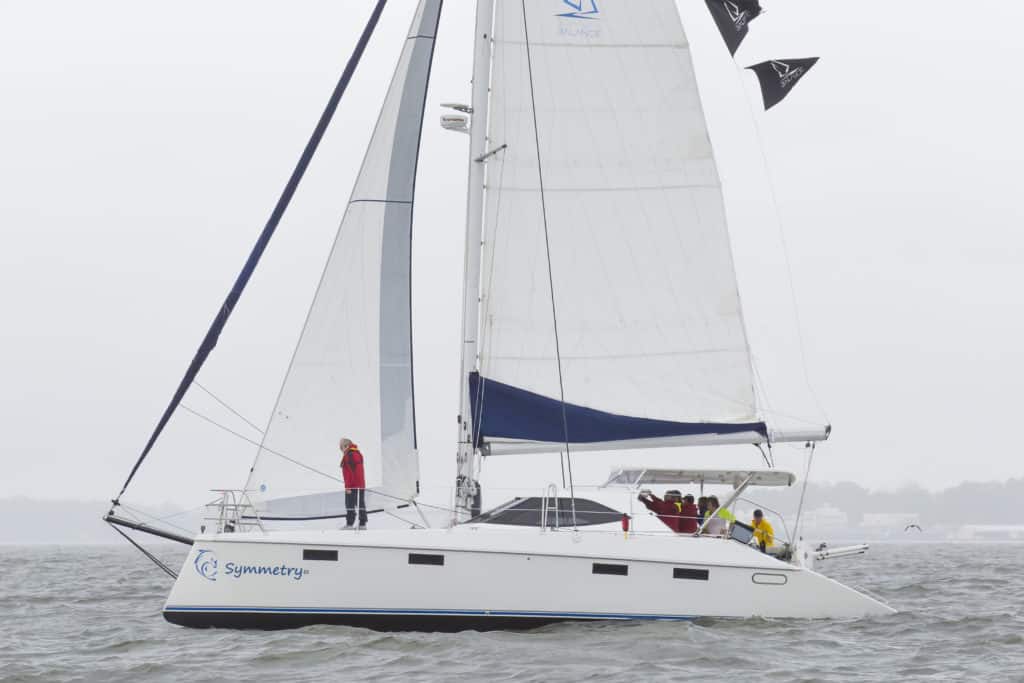
Many of today’s lighter, more modern cruising boats have evolved to have bigger mainsails and smaller, non-overlapping jibs. “The new designs make it easier for couples to sail without help, and more comfortable for older sailors to stay sailing in bigger boats,” says Bob Pattison, of Neil Pryde Sails. The big-main, small-jib setup is great for sailing upwind in breeze, but as the wind dies, the decreased sail area up front might not have enough power to keep the boat moving. Enter the light-air reaching sail, with its vast array of names. Some of these terms describe a specific shape, but many are used by marketers to differentiate between brands. Among the different monikers are the gennaker, reacher, screacher (a term used primarily for multihulls), drifter, light-air genoa and cruising code zero (the flattest variation). Grouped collectively under the name “reacher,” they are ideal for those hot zero- to 10-knot days, when they can take you from drifting to moving. They are generally a bit flatter and slimmer than a running spinnaker and have a straighter luff. Having your boat measured by a sailmaker makes a big difference in how well the furler will work, says Chuck Allen, of North Sails. “Once you set it up nicely on your boat,” he adds, “you should be able to pull the cord and it will roll up like a window shade.”
Doyle’s reacher, the Utility Power Sail, “is the link between a headsail and a spinnaker, with a wider usable wind range than either,” says Chris Howes, of Doyle. These sails excel in light air upwind but can also be cracked off in a wide range of reaching angles as the breeze builds.
“In some of the modern boats, reaching becomes a challenge because of the lack of horsepower in the smaller jib,” says Bruce Cooper, of Ullman Sails Newport Beach, who notes that having a more powerful reacher forward can help balance a large mainsail. Ullman’s cruising code zero has a range of between 50 and 90 degrees apparent (close to beam reach) and can also be sailed wing on wing, like a big genoa on a dead run. More versatility can be added to these reaching sails if they’re designed and cut with more sail area in the middle of the sail. Bruce Cooper says these sails are for 3 to 15 knots, and their range of wind angles is much deeper, at 85 to 120 degrees (close to broad reaching).
Unless you go all the way to wing on wing, sailing very deep off the wind presents challenges for this category of sail shape. In particular, the sails lose their effectiveness at apparent-wind angles aft of 130 degrees (a broad reach). But Neil Pryde’s Pattison says the negative downwind performance is “overcome by the true ease of handling.”
If you have an older-style boat like a Bristol 41.1 — which often flies a large (130 to 150 percent) overlapping genoa — your sails may already be quite good at reaching, says Quantum’s David Flynn. In this case, a code-zero style would be less important. A spinnaker, though, would still be great for running.
Laminate vs. Woven
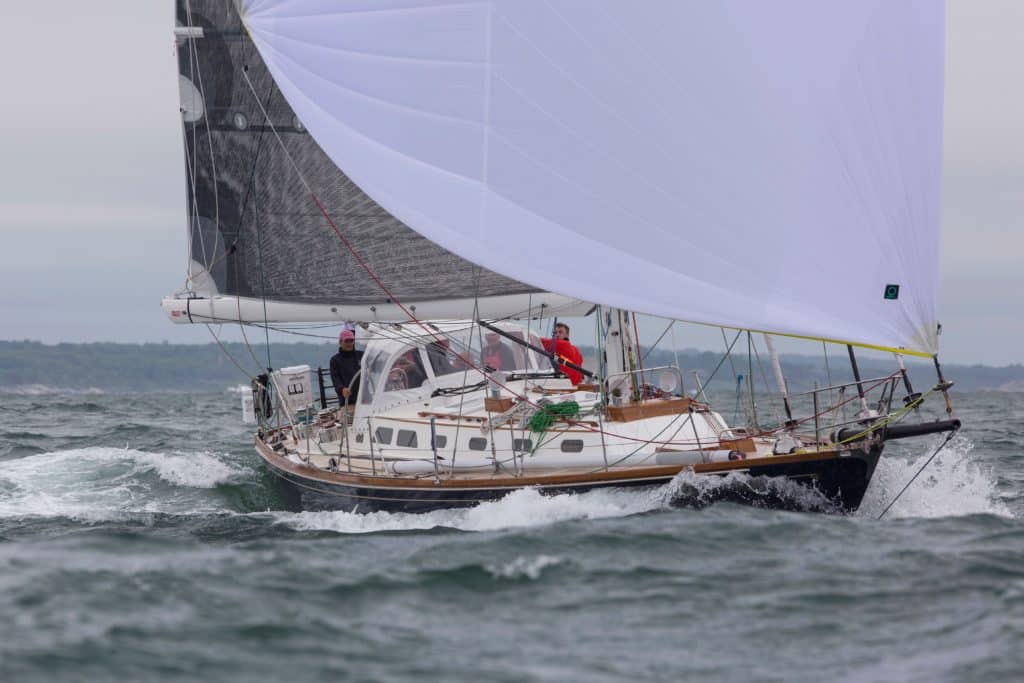
Downwind spinnakers are almost always made of a woven fabric such as nylon or polyester, but reachers — especially flatter code-zero types — can be made of laminate materials. Laminates are lighter-weight, provide more performance in terms of speed, and hold their shape better over time, but are more expensive and don’t stand up well to flogging.
Quantum’s Flynn notes that the strength of a laminate may be necessary for a close-reaching sail on bigger boats because the apparent-wind velocity is so much stronger when sailing close to the wind. Woven sails are less expensive and can tolerate more flogging and general abuse, but will have more stretch. “A nylon chute can be stuffed into a bag, sat on, pushed into a locker, the kids can sleep on it, and it won’t cause any problems,” says Hood’s Joe Cooper. If you choose a nylon sail, however, he warns that heat, humidity and time can cause the colors to bleed.
Not all asymmetric sails for top-down furlers fly freely away from the torsion cable with attachments at the head and tack. Racing-oriented styles have the torsion cable enclosed in a luff sleeve and look more like a big genoa. The way your sail attaches to the furler can play a role in fabric choice. Patrick Murray, of North Sails, says the firmer cloth of laminates is preferable for close-reaching sails whose anti-torsion cable is carried inside the luff. Lighter nylon or polyester spinnaker cloth is better suited to the type of “bunched-up” furling that is accomplished with sails connected to the torque rope only at the head and tack.
Whichever sail you choose — spinnaker or reacher — you’ll need to think about how it will be set. The bows of many older boats accumulate anchors, jib furlers, bow pulpits, nav lights, lifeline cotter pins and other gear, says Joe Cooper. It may be worth it to rig a short bowsprit to get the tack forward of the clutter to minimize damage to the sail and ensure a straight line from head to tack for proper furling. That said, Spencer Colpaert, of Quantum, warns that you may need a bobstay to keep the sprit from flexing. Insufficient tension on the torsion cable can inhibit proper rolling of the sail.
Talk to your sailmaker about the boat and sails you already own and the type of sailing you plan to do. Whether it’s a deep downwind chute or a light-air reacher, ideally you’ll choose a sail that fills a gap in your current inventory.
Read tips on furling downwind sails from sailmakers here.
Watch top-down furlers in action here.
————
Eleanor Merrill is CW’s managing editor.

